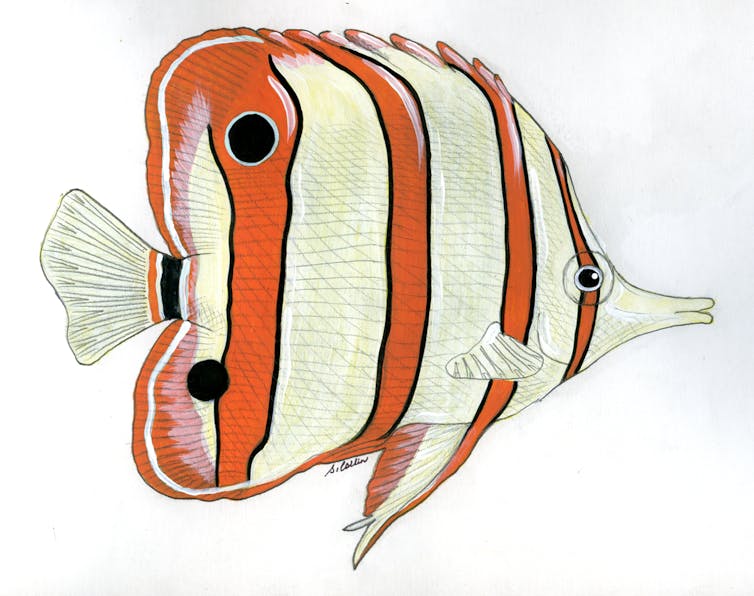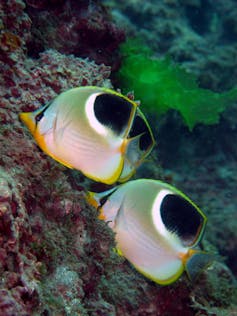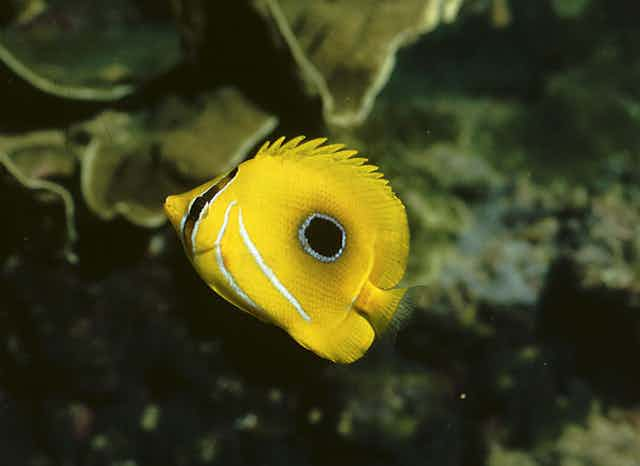Have you ever wondered why coral reef fishes are so brilliantly coloured and bizarrely patterned? A quick flick through any coral reef fish guide will leave you bewildered and awed.
To answer this question, we need to think about what animals, in general, use their colour patterns for. There is, in fact, a range of uses: for instance, many must have patterns that are both eye-catching to would-be mates but also appear cryptic to lurking predators.
My colleagues, Dr John Fitzpatrick at University of Manchester, UK, Dr Sami Merilaita at Abo Akademi University, Finland, and I, recently used a “comparative approach” to try to unravel the mystery behind the evolution of spots and stripes in butterflyfishes in our original research, published today in Proceedings of the Royal Society B.
We tested a number of predictions about how these markings should evolve if they help butterflyfishes avoid being eaten.
So, what significant questions were we able to answer?
Can your colour patterns help you avoid being eaten?
Camouflage is a well-known way for prey to avoid being eaten, but it is not the only tactic. Striking markings such as spots and stripes can deceive or dazzle predators to foil attempted attacks.
Markings such as spots and eyespots (circles with a ring around the outside) are a particular source of intrigue for biologists and are common in a number of animals, including coral reef fishes.

The idea that spots and eyespots might help prey to avoid being eaten by predators has been around for some time. Eyespots might intimidate or scare predators by mimicking the eyes of the predators’ enemies.
Another idea is that they deceive predators by giving the impression of a head at the wrong end of the body. While some of these ideas have gained support from studies of butterflies and moths, the role of these markings in fishes has remained a mystery.
Why have spots and stripes evolved?
One exciting way to tackle these sorts of evolutionary questions is to use a comparative approach – as we did – which allows you to link a species’ colour patterns with its ecology, while taking into account shared ancestry (because closely related species are more likely to resemble one another).
We obtained phylogentic data (showing the evolutionary relationships among species) on the butterflyfish family from original research published by Professor David Bellwood and colleagues at James Cook University. We then collected data on the colour patterns and ecology of each species by examining fish guide books, orginal research papers and online resources.
To our surprise, we found little support for the idea that spots provide protection from predators. But we noticed that fish with spots and eyespots always had eye stripes. These markings obscure the eye, perhaps diverting attention away from the eye and towards the spot or eyespot.
Have stripes evolved for multiple purposes?
When we looked at the evolution of striped patterns, we found species that were often found in shoals had fewer stripes.
Perhaps shoaling species tend to inhabit open water where their lack of patterning allows them to be camouflaged against the plain background. We also found that butterflyfish with broad diets tended to have more stripes.
If stripes work to break up the fish’s body outline, maybe these markings allow fish to expand their feeding activity to a greater number of habitats. There are many possible explanations for our findings, not all of which are related to predator defence.

Beauty is in the eye of the beholder
One of the most important things to remember when studying the patterns and colours of animals is that animals have very different visual systems to humans. In fact, many fish may have a system of colour vision that is far more complex than our own.
An influential paper published in 2000 by Professor Justin Marshall at The University of Queensland illustrates this key point. Professor Marshall showed patterns that appear bright and bold to us might actually appear rather drab to fish, particularly if they are viewed from a distance.
One future challenge is to figure out how patterns such as spots and stripes appear when viewed through the eyes of the fish. Only then can we start to understand and explain the astonishing diversity of reef fish colour patterns.

